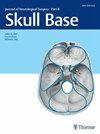Skull base repair following resection of vestibular schwannoma: a systematic review (Part 2: The Translabyrinthine Approach)
IF 0.9
4区 医学
Q3 Medicine
引用次数: 0
Abstract
Objectives: Despite advances in skull base reconstruction techniques, cerebrospinal fluid (CSF) leaks remain a relatively common complication after translabyrinthine (TL) vestibular schwannoma (VS) surgery. We conducted a systematic review to synthesise the repair techniques and materials used in TL VS surgery to prevent CSF leaks. Design: A systematic review of studies published since 2000 reporting techniques to prevent CSF leaks during adult TL VS surgery was conducted. A narrative synthesis of primary repair protocols was produced, and a taxonomy was established. Additionally, the advantages, disadvantages, and associated CSF leak rates of different repair protocols were extracted. Results: All 43 studies were case series, and 39 were retrospective. Repair strategies included heterogeneous combinations of autografts, xenografts, and synthetic materials. A taxonomy was produced, classifying repairs into seven distinct stages, including approaches to the dura, middle ear cleft, air cells, TL bony defect, extra-cranial soft tissue, post-operative dressings and CSF diversion. The median post-operative incidence of CSF leaks was 6% (IQR 0-10%). Conclusions: This systematic review reveals substantial inter-institutional heterogeneity in intraoperative strategies to prevent CSF leaks following TL VS surgery. However, comparing these techniques is challenging due to the multiple predictive factors for CSF leaks and their inconsistent reporting. We propose a taxonomy of seven stages to classify operative techniques and materials aimed at preventing CSF leaks. We recommend that future evaluations should adopt a prospective approach encompassing data collection strategies that consider all operative stages described by our taxonomy.前庭分裂瘤切除术后的颅底修复:系统性综述(第 2 部分:经迷路方法)
目的:尽管颅底重建技术有所进步,脑脊液(CSF)泄漏仍然是经迷路(TL)前庭神经鞘瘤(VS)手术后相对常见的并发症。我们进行了一项系统的综述,以综合在TL VS手术中用于防止脑脊液泄漏的修复技术和材料。设计:对2000年以来发表的关于成人TL VS手术中预防脑脊液泄漏技术的研究进行系统回顾。对主要修复方案进行了叙述综合,并建立了分类。此外,还提取了不同修复方案的优点、缺点和相关的脑脊液泄漏率。结果:43项研究均为病例系列研究,39项为回顾性研究。修复策略包括自体移植物、异种移植物和合成材料的异质组合。将修复分为七个不同的阶段,包括硬脑膜入路、中耳裂、空气细胞、TL骨缺损、颅外软组织、术后敷料和脑脊液分流。术后脑脊液渗漏的中位发生率为6% (IQR 0-10%)。结论:本系统综述揭示了在术中预防tlvs手术后脑脊液泄漏的策略存在很大的机构间异质性。然而,由于脑脊液泄漏的多种预测因素和不一致的报告,比较这些技术具有挑战性。我们提出了一个分类的七个阶段,分类的手术技术和材料,旨在防止脑脊液泄漏。我们建议未来的评估应采用前瞻性的方法,包括考虑我们分类法所描述的所有操作阶段的数据收集策略。
本文章由计算机程序翻译,如有差异,请以英文原文为准。
求助全文
约1分钟内获得全文
求助全文
来源期刊

Journal of Neurological Surgery Part B: Skull Base
CLINICAL NEUROLOGY-SURGERY
CiteScore
2.20
自引率
0.00%
发文量
516
期刊介绍:
The Journal of Neurological Surgery Part B: Skull Base (JNLS B) is a major publication from the world''s leading publisher in neurosurgery. JNLS B currently serves as the official organ of several national and international neurosurgery and skull base societies.
JNLS B is a peer-reviewed journal publishing original research, review articles, and technical notes covering all aspects of neurological surgery. The focus of JNLS B includes microsurgery as well as the latest minimally invasive techniques, such as stereotactic-guided surgery, endoscopy, and endovascular procedures. JNLS B is devoted to the techniques and procedures of skull base surgery.
 求助内容:
求助内容: 应助结果提醒方式:
应助结果提醒方式:


